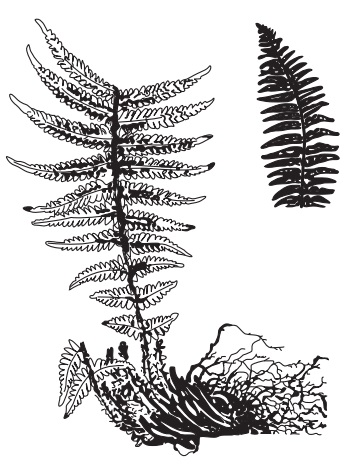Male Fern
| Home | | Pharmacognosy |Chapter: Pharmacognosy and Phytochemistry : Drugs Containing Resins
Male fern consists of the dried rhizomes and its surrounding frond bases of Dryopteris filix-mas (Linn.) Schoot, belonging to family Polypodiaceae.
MALE FERN
Synonyms
Filix Mass, Rhizoma Filicis Maris.
Biological Source
Male fern consists of the dried rhizomes and its surrounding
frond bases of Dryopteris filix-mas
(Linn.) Schoot, belonging to family Polypodiaceae.
Geographical Source
D. filix-mas is a fern that grows abundantly in
Europe especially in England and
Germany. In India it grows in Kashmir, Himachal Pradesh, and Sikkim at the
altitude of 5,000–10,000 feet in the Himalayas.
Collection and Preparation
The male fern plant is identified on the basis of its oblique
rhizomes surrounded by numerous frond bases. The fronds bear numerous long
pinnae containing several pairs of pinnules. The plant is dug up in the late
autumn. It is washed thoroughly with water. The roots, fronds and the other
dead parts are removed, and the trimmed rhizomes are dried. Longer rhizomes are
longitudinally cut into two halves for faster and efficient drying.
Characteristics
The dried male fern rhizomes are ovoid or cylindrical
pieces, about 7–25 cm long and 3–4 cm thick. The outer surface is mostly
covered by fronds which are directed towards the apex. Each frond base is about
45 cm long and is thickly covered with numerous brownish seals called as
ramenta. The rhizomes break with a short fracture showing green surface. The
rhizomes are brownish black in colour with little odour but sweet, bitter and
extremely nauseating taste. The drug should be stored in dry places protected
from light.

Microscopy
The transverse section of male fern rhizome with frond bases
shows the presence of ground tissue consisting polygonal parenchyma along with
abundant starch grains. The hypodermis consists of two to three rows of
brownish nonlignified sclerenchymatous fibres. Meristemes possesses large
tracheids. The ramenta are made up of twin-cell marginal projections.
Chemical Constituents
Male fern rhizomes contain about 5% of yellow resin-ous
substances responsible for its anthelmintic activity. The major constituents of
oleoresin are phloroglucinol derivatives of mono- to tetracyclic compounds. The
mono-cyclic derivatives are butyryl phloroglucinol, aspidinol and acylfilicinic
acids. These compounds may condense with each other to produce bicyclic
compounds such as albaspidin and flavaspidic acid or tricyclic compounds like
filicic acid.

Uses
Male fern extract and the resin are used as a potent
taenicide. It kills the worm and expels it out. Considerable care has to be
undertaken during its use. Large doses acts as irritant poison. Its absorption
from gastrointestinal tract may cause blindness.
Marketed Products
It is one of the ingredients of the preparation known as Paratrex
(Global Healing Centre).
